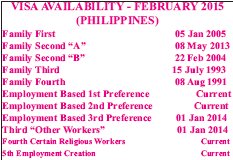By: Robert Gard
 It’s New Year’s! It’s Also Traditionally the Time for Lists: Top Immigration Stories of 2014 This past year, immigration issues have taken us on a roller-coaster ride filled with anxiety, raised hopes, dashed hopes, promising hints, and political theatrics; and capped off with a grand executive action borne of weariness, frustration and political obstruction. While all end-of-year lists are at least somewhat subjective, this is my list (in no particular order) of the 2014 highlights and lowlights of immigration.
It’s New Year’s! It’s Also Traditionally the Time for Lists: Top Immigration Stories of 2014 This past year, immigration issues have taken us on a roller-coaster ride filled with anxiety, raised hopes, dashed hopes, promising hints, and political theatrics; and capped off with a grand executive action borne of weariness, frustration and political obstruction. While all end-of-year lists are at least somewhat subjective, this is my list (in no particular order) of the 2014 highlights and lowlights of immigration.
Ongoing (and Seemingly Unstoppable) Border Patrol Abuses
This year also saw an increasing focus on the abuses of federal immigration agents at the border. The American Immigration Council and many civil liberties organizations uncovered and publicized numerous instances evidencing the lack of accountability and transparency which afflicts the U.S. Border Patrol and its parent agency, U.S. Customs and Border Protection (CBP) in a report titled No Action Taken: Lack of CBP Accountability in Responding to Complaints of Abuse. Based on data obtained through FOIA, the report shows than more often than not complaints of abuse filed with CBP result in no action taken against the Border Patrol agents accused of the abuse.
There are also numerous charges of arrested and detained (undocumented) immigrants being stripped of their meager possessions and personal effects before being sent back to their home countries, with little or no accounting of the property seizures. In response, CBP leadership made public new measures designed to increase the agency’s openness and transparency. In December, Department of Homeland Security Secretary Jeh Johnson announced that CBP will now have criminal authority to investigate complaints within the organization. In addition, CBP is adopting a unified, formal review process for use of force incidents, which will allow the agency to “effectively respond to, investigate, coordinate, report, review and resolve use of force incidents in a timely manner.”
The Failure to Designate the Philippines for a Grant of “TPS” (Temporary Protected Status) After Typhoon Haiyan and Subsequent Typhoons
OK, this is one that I got wrong. I was pretty sure that the Department of Homeland Security would approve the Philippines for a grant of TPS, to prevent undocumented and out-of-status Filipinos from being deported from the US back to the Philippines, while that country was trying to recover from the effects of that deadly typhoon. A grant of TPS would have also had the effect of shuttling significant sums of US dollars to the Philippines in currency remittances to families back home.
This would have been an action that could have been taken by the Executive Branch without approval of Congress, and it would have likely resulted in significant electoral support for Democrats in the 2014 mid-term elections from a Fil-Am voting population that has traditionally been pretty evenly split between the two parties.
My best guess as to why the Obama Administration failed to do the politically astute and expedient thing, and grant TPS is that the Administration was wary of the huge numbers of “removable” Filipinos who could have benefitted from a grant of TPS (more than the aggregate number of TPS beneficiaries for all Central/South American countries that have already been granted TPS), and the US was still nursing a grudge from the loss of their military bases in the Philippines. Whatever the reason, the Obama Administration passed up the chance to do the right thing both from a humanitarian and a political standpoint.
Central American Families Fleeing Violence
The number on unaccompanied minors arriving has risen at a concerning rate in the past few years, but it peaked this summer when tens of thousands of immigrant children and women arrived at our southern border after making the harrowing journey from Central America and Mexico to the north. These children fled countries that are not only some of the most violent in the world, but countries where the rule of law is in tatters.
The White House asked Congress for additional funding for an aggressive border enforcement strategy while also setting up a temporary detention facility in Artesia, New Mexico. The facility (since closed and replaced earlier this month with a new privately run “family detention” facility in Dilley, Texas) holds the mothers and children who arrived and allows the government to fast-track their deportations despite the fact that many are seeking safety from the death threats, rape, and other abuses in their home countries.
Somehow, I don’t think that immigration activists’ impassioned pleas to keep immigrant families together is advanced in any way by keeping them together in for-profit detention facilities in Texas. Another political decision guided by the principles of “followthe- money.”
US House of Representatives’ Failure to Act on Immigration Reform
After the Senate approved S. 744, its immigration bill, in July 2013, this year started with hope that the House would take action as well. In January 2014, Speaker Boehner released the House Republicans’ principles of immigration reform, but those guidelines did not lead to a renewed push for reform. House Democrats attempted to force Boehner to call a vote on H.R. 15 when they filed a discharge petition in March, but it did not receive enough votes.
Instead of offering a legislative solution to the broken immigration system, the House voted on piecemeal measures that failed to address the problems the immigration system faces. For example, before the August recess, House Republicans approved a bill that allocated only a fraction of the funds needed to address the humanitarian situation surrounding unaccompanied children and passed a bill to end DACA (the Senate never voted on these) because many Republicans claim the program incentivized Central American immigrants to cross the U.S. border.
President Obama’s Executive Action on Immigration Announced on November 20, 2014
Clearly the major “immigration story” of 2014, President Obama announced on November 20, 2014 his “immigration accountability executive action,” which ranged from new temporary immigration protections for many unauthorized parents of U.S. citizens and lawful permanent residents to highly technical regulatory proposals to fix outdated visa provisions.
I covered this announcement in greater depth in last month’s VIA TIMES Immigration Update article, and we are still awaiting clarifications and further instructions from the Department of Homeland Security. The series of changes, updates, and temporary measures Obama announced relies on the expansion of successfully implemented programs (i.e., Deferred Action for Childhood Arrivals), enhanced efforts to coordinate immigration enforcement and benefit policies across agencies, and attempts to use immigration as a tool of economic and social change. But they are temporary and reflect the limits of executive authority, serving as little more than a Band- Aid until Congress approves a longterm solution.
For more than a year prior to his November 20th announcement, President Obama had insisted (in more than 20 public announcements) that he lacked unilateral authority to address America’s dysfunctional immigration policies, that is, until he got fed-up with inaction in Congress, changed his mind, and actually gave it a shot. Don’t expect the “roll-out” of the President’s Executive Orders to go forward without any hitches. Several States and governors have already filed suit in Federal Courts to have the “overreaching” executive orders declared unconstitutional and are discussing other obstructive tactics to be used as soon as the new Republican majority in both houses legislature is sworn into office in January.
Within days of the President’s November 20th announcement, an electronic bulletin reached inboxes across bureaucratic Washington. USCIS said it was immediately seeking 1,000 new employees to work in an “operational center” office building in the Crystal City neighborhood of Arlington, Virginia, to process “cases filed as a result of the executive actions on immigration.”
Rent for those offices should be about $8 million a year, and salaries of the new personnel should be roughly $40 million annually.
USCIS Director, Leon Rodriguez, announced that more than 5,000 people have already submitted applications for these new jobs. USCIS officials say they are eager to put in place the infrastructure needed to allow undocumented people (covered by the executive actions) to apply for work permits by the early spring. That will require a new website, application forms and people to run background checks and process application fees that will probably be several hundred dollars (I’ve seen reports stating that the “DAPA” filing fees will be $465.)
Several years back, Congress passed laws that require USCIS to be self-funding through filing fees, so that USCIS doesn’t get money from Congressional appropriations. This provides an advantage to the President, in that Congressional threats to “de-fund” his executive actions are empty threats if Congress isn’t providing funds to USCIS in the first place.
However, USCIS doesn’t just have $48 million sitting around under their mattress to pay for rent and additional personnel until the filing fees start rolling in from new applicants for relief under these executive actions, so USCIS will need to shift some of their funds around to cover start-up costs, and this is where Congress may decide to make mischief, by blocking such fund shifting through legislation.
Fortunately, President Obama has a “VETO” stamp, and it looks like that veto stamp will get quite a workout in 2015.
COPYRIGHT BY AUTHOR — 2015 This article is designed to provide accurate and authoritative information in regard to the subject matter covered. It is published and distributed with the understanding that the publisher is not engaged in rendering legal, accounting or other professional service. It is submitted for publication by the author with the understanding that each individual case is different, and this article is not a formal legal opinion and should not be relied upon as advice by the author in a particular legal situation.
Mr. Gard has been engaged in the practice of immigration law since 1977. He is a frequent writer and lecturer in the American Immigration Lawyers Association and has served that professional organization as a Chapter Chair of the Greater Chicago Chapter, and as a Director. Written questions may be submitted to Mr. Gard. At his discretion, selected questions or issues may be addressed in subsequent articles. Mr. Gard is available for appointments for consultation in immigration law-related matters at the law offices of Immigration Attorneys, LLP, 203 North LaSalle Street, Suite# 1550, Chicago, Illinois 60601, Contact Information (email is the preferred method of contact): e-mail: rgard@immattyllp.com U.S.
 VIA Times – January 2015 Issue Vital News, Vibrant VIews for Asian Americans in Chicago & Midwest
VIA Times – January 2015 Issue Vital News, Vibrant VIews for Asian Americans in Chicago & Midwest




